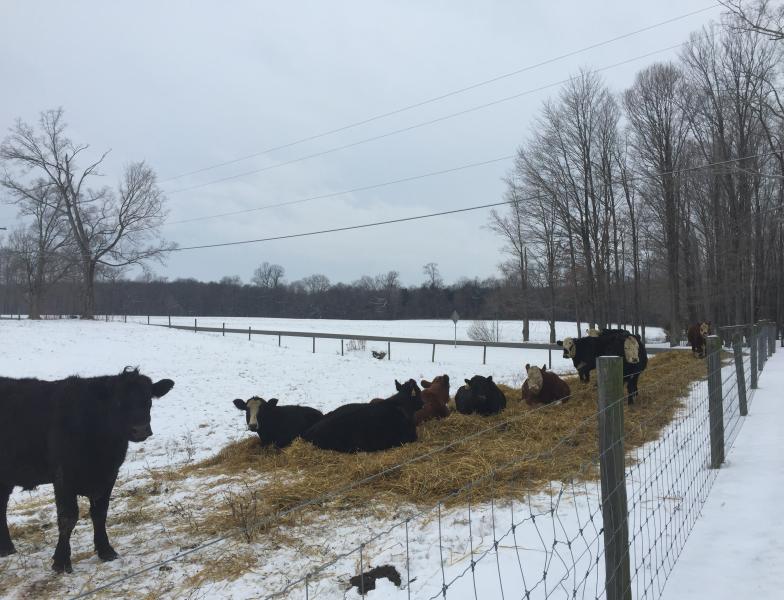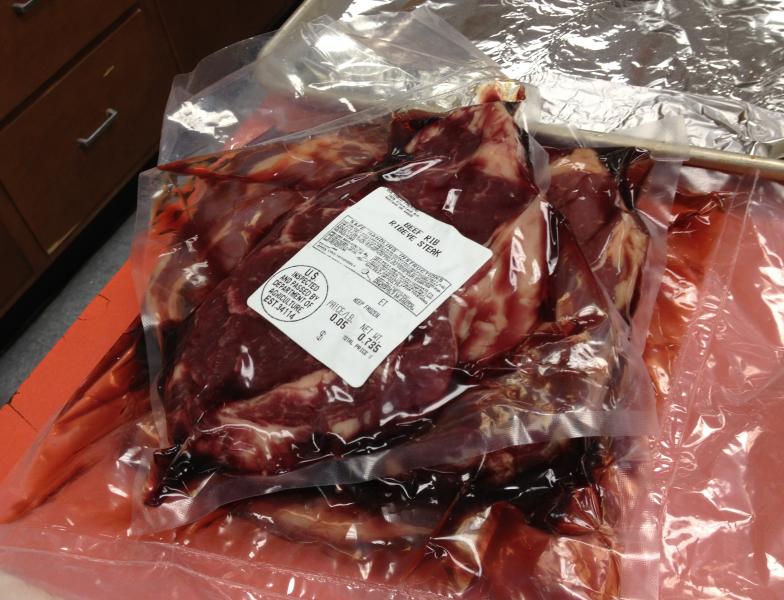“Come on Red. Come on Blackie.”
On his Kinsman ranch, Aaron Miller calls out to his cows. He also raises lambs and pigs on grass.
“Here you’ll see that cows are laying outside. They’re perfectly content even though there’s snow on the ground.”
The cows have plenty of room to roam. “We have about 300 acres total, and there’s about 200 acres of grass altogether.”
That’s two kinds of grass. He says his clover sends nitrogen into the soil that feeds his orchard grass.
Mutual support
“It’s a circle of nature. Both plants need each other, and they need the cattle to re-fertilize the ground.”
On this blustery January day, the cows relax on piles of hay Miller and his wife Melissa have laid out for them on the deep snow. There’s more baled hay they can munch on in the barn. Melissa have laid out for them on the deep snow. There’s more baled hay they can munch on in the barn.
“They’ll lay out here,” says Melissa, “and then they’ll go in the barn and eat, and then come back out and get a drink of water, and they’ll come back out and lay down again. So, it’s a good life.”
A good life for the Millers, too, they say, since they switched 17 years ago from feeding their livestock corn, soy and grains to letting them graze freely on organic pastures.
They did it for a couple of reasons including, says Aaron Miller, "we wanted to get away from the use of chemicals."
Chemicals are not needed
Unlike feedlot cattle kept in crowded pens and susceptible to disease-causing pathogens, the Millers’ cows need no antibiotics.
The FDA’s been cracking down lately on overuse of antibiotics on healthy animals. About 80 percent of antibiotics sold in the U.S. are fed to cattle and poultry, and many health organizations, including the American Medical Association are worried about it causing antibiotic resistance in humans.
Aaron Miller's own dietary restrictions also factored into his decision to raise his livestock on grass.
“I have hereditarily high cholesterol that is not controlled by drugs. So we had to come up with a different kind of a lifestyle.”
 Miller believes leaner, grass-fed beef is keeping him well. Miller believes leaner, grass-fed beef is keeping him well.
And many health conscious carnivores seem to agree.
Growing demand
In the past decade, demand for grass-fed beef has grown at an annual rate of 25 to 30 percent.
But it still represents less than 3 percent of all U.S. beef sales.
One reason may be the cost.
“You’ll probably pay 10 maybe 20 percent more.”
The Center for Food Integrity, a food industry-funded non-profit, says that’s a problem, because the rising cost of food is a top consumer concern.
But Melissa, the cook in her farm family, says the taste of grass-fed beef is worth every extra penny.
"It’s full of flavor, has a very clean-mouth finish. People say all the time it tastes like what I grew up on, how my grandmother used to make it.”
A cook’s perspective
From a culinary standpoint, Tricia Wheeler heartily agrees.
“It’s kind of like beef how it used to be.”
Wheeler’s the editor of Edible Columbus magazine.
“I teach a very busy series of cooking classes in Columbus, and that’s where my passion lies is helping the home cook.”
We caught up with Wheeler at a grass-fed beef workshop in Granville. 
“So we’ve got these ribeyes going up here. What do you guys think of the pot roast so far? You like the pot roast? OK. So I’ve got some nice caramelization. I’m not going to cook these much longer.”
Low and slow
The steaks sizzle quickly, but for the pot roast she goes low and slow. She roasted it for four hours the night before.
“And then today I came back with a crockpot, and I’ve been cooking it here since this morning. It’s very tender now. This is what you want to see, just when I picked it up with a fork it was just falling away.”
She says different cuts require different techniques.
For her London broils, she scores the meat to let the marinade seep in and start to tenderize them.
With steaks, she suggests searing, "which would give some of those caramelization pieces in a hot cast-iron skillet,
 with your oil and crusted with peppercorns and garlic. But then finish it in the oven and watch the temperature. The temperature is really the thing that dries out meat. It’s not the cut.” with your oil and crusted with peppercorns and garlic. But then finish it in the oven and watch the temperature. The temperature is really the thing that dries out meat. It’s not the cut.”
Keep it simple
To get started cooking grass-fed beef, she suggests a cut you don’t have to fuss with much.
“Using a brisket cut is a wonderful way to make a really flavorful pot roast. It think it’s all about choosing the right cut for the right technique at the right temperature.”
The key thing, she says, is not to overcook it.
“Even if you prefer things really well-done, try it medium-rare. That’s going to give you the best tender, juicy result.” |